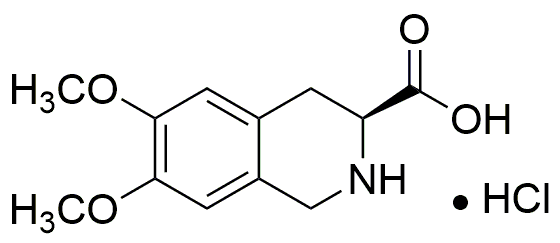(S)-(-)-6,7-Dimethoxy-1,2,3,4-tetrahydroisoquinoline-3-carboxylic acid hydrochloride is widely utilized in research focused on:
- Pharmaceutical Development: This compound is explored for its potential therapeutic effects, particularly in neuropharmacology, where it may aid in the development of treatments for neurological disorders.
- Natural Product Synthesis: It serves as a key intermediate in the synthesis of various natural products, enhancing the efficiency of creating complex molecules in organic chemistry.
- Biochemical Research: Researchers use it to study enzyme interactions and metabolic pathways, providing insights into cellular processes and disease mechanisms.
- Analytical Chemistry: The compound is employed in analytical methods, such as chromatography, to help identify and quantify other substances in complex mixtures.
- Drug Formulation: Its unique properties make it suitable for formulating new drug delivery systems, potentially improving bioavailability and therapeutic efficacy.
Informations générales
Propriétés
Sécurité et réglementation
Applications
(S)-(-)-6,7-Dimethoxy-1,2,3,4-tetrahydroisoquinoline-3-carboxylic acid hydrochloride is widely utilized in research focused on:
- Pharmaceutical Development: This compound is explored for its potential therapeutic effects, particularly in neuropharmacology, where it may aid in the development of treatments for neurological disorders.
- Natural Product Synthesis: It serves as a key intermediate in the synthesis of various natural products, enhancing the efficiency of creating complex molecules in organic chemistry.
- Biochemical Research: Researchers use it to study enzyme interactions and metabolic pathways, providing insights into cellular processes and disease mechanisms.
- Analytical Chemistry: The compound is employed in analytical methods, such as chromatography, to help identify and quantify other substances in complex mixtures.
- Drug Formulation: Its unique properties make it suitable for formulating new drug delivery systems, potentially improving bioavailability and therapeutic efficacy.
Documents
Fiches de données de sécurité (FDS)
La FDS fournit des informations de sécurité complètes sur la manipulation, le stockage et l’élimination du produit.
Spécifications du produit (PS)
Le PS fournit une description complète des propriétés du produit, notamment sa composition chimique, son état physique, sa pureté et les exigences de stockage. Il détaille également les plages de qualité acceptables et les applications prévues du produit.
Certificats d'analyse (COA)
Recherchez des certificats d'analyse (COA) en saisissant le numéro de lot du produit. Les numéros de lot et de lot se trouvent sur l'étiquette d'un produit, après les mots « Lot » ou « Lot de fabrication ».
Numéro de catalogue
Numéro de lot/série
Certificats d'origine (COO)
Ce certificat d'exploitation confirme le pays dans lequel le produit a été fabriqué, et détaille également les matériaux et composants utilisés et s'il est issu de sources naturelles, synthétiques ou autres sources spécifiques. Ce certificat peut être requis pour les douanes, le commerce et la conformité réglementaire.
Numéro de catalogue
Numéro de lot/série
Fiches de données de sécurité (FDS)
La FDS fournit des informations de sécurité complètes sur la manipulation, le stockage et l’élimination du produit.
DownloadSpécifications du produit (PS)
Le PS fournit une description complète des propriétés du produit, notamment sa composition chimique, son état physique, sa pureté et les exigences de stockage. Il détaille également les plages de qualité acceptables et les applications prévues du produit.
DownloadCertificats d'analyse (COA)
Recherchez des certificats d'analyse (COA) en saisissant le numéro de lot du produit. Les numéros de lot et de lot se trouvent sur l'étiquette d'un produit, après les mots « Lot » ou « Lot de fabrication ».
Numéro de catalogue
Numéro de lot/série
Certificats d'origine (COO)
Ce certificat d'exploitation confirme le pays dans lequel le produit a été fabriqué, et détaille également les matériaux et composants utilisés et s'il est issu de sources naturelles, synthétiques ou autres sources spécifiques. Ce certificat peut être requis pour les douanes, le commerce et la conformité réglementaire.

